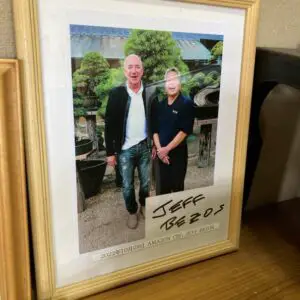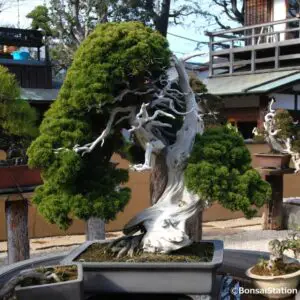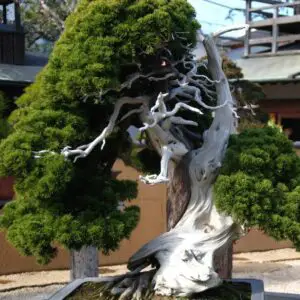You might be wondering why miniature trees like bonsai are often so expensive.
There are a few reasons why bonsai trees become so expensive: value as an art piece, value as an antique, value of rarity, value of unique skills involved, value of the bonsai artist, value of provenance, value of the bonsai pot, money and time invested, and the difficulty of moving trees internationally.
What determines the price of a bonsai tree?
The price of a bonsai tree depends on a variety of factors but here are the main factors that affect the price of a bonsai tree the most:
- Age
- Rarity
- Unique skills
- Creator (bonsai artist)
- Quality and condition
- Provenance
- Species and demand
- Investment in time and money
- Price of the bonsai pot
Age
The age of the bonsai tree is the most influential factor in its price. You can understand an ancient bonsai tree that has been trained and shaped over a few centuries is more expensive than a younger bonsai tree that is a few years old.
Rarity
A rarity for a specific type of bonsai tree can drive up its price. Rarity reflects the difficulty of cultivation. Some species can live for a few decades in a tiny pot but may not survive beyond that. A bonsai tree that is unique is likely to be more expensive than a more common variety that we can grow easily.
Unique skills
The uniqueness of skills is also a factor in pricing bonsai trees. Bonsai cultivation needs unique skills and becoming a specialized bonsai grower is not an easy task; it requires a significant amount of time, dedication, and knowledge and it is reflected in the price of a bonsai tree.
Creator (bonsai artist)
The creator/artist is also an important factor to look at appraising a bonsai tree. Some bonsai artists are more well-renowned and their artwork (=bonsai) is priced higher than the ones grown by ordinary bonsai growers.
Quality and condition
The overall quality and condition of the bonsai tree also affect its price. A bonsai tree that has been well-trained and shaped in a natural yet dynamic way with good health is more expensive than a poorly shaped and unhealthy tree.
Provenance
Provenance, the history of ownership, can also affect a bonsai tree’s price. If you can prove that a bonsai tree was once owned by someone historically famous, such as some shogunate, aristocrat or emperor, it will likely command a much higher price.
Species and demand
The species of the bonsai tree and demand for them can greatly affect its price. It is like a fashion trend. Some species are rarer at a certain era, everybody is interested in and therefore more expensive, while others are more common and less expensive.
Investment in time and money
The time and money that went into creating the bonsai tree also affect its price. Creating a bonsai tree is labor-intensive that takes many, many years. This investment in time and money is reflected in the cost of a bonsai tree.
Price of bonsai pot
The price of the bonsai pot also affects a bonsai tree’s price. A bonsai pot is in itself a form of art and can greatly affect the price of a bonsai tree. A good bonsai pot is like expensive antique dishware that is hand-crafted by skilled artisans and the pot’s price is reflected in the price of a bonsai tree.
Why are bonsai trees so expensive?
Bonsai is the Art of Miniature Landscape: a natural landscape created with plants in a bonsai pot. Bonsai being an artwork, the factors determining the price of a bonsai tree can be somewhat ambiguous but there are a few reasons why bonsai trees become so expensive:
- Value as an art piece
- Value as an antique
- Value of rarity
- Value of unique skills involved
- Value of the bonsai artist
- Value of provenance
- Value of the bonsai pot
- Money and time invested
- Difficulty of moving trees internationally
Value as an art piece
Bonsai trees are a form of living art, and as such, they can be valued for their artistic qualities. While there are certain factors affecting its price, the artistic value of a bonsai tree can be subjective and vary from person to person. A work of art that one person finds beautiful and valuable may not hold the same appeal for another person.
It is like a painting by Van Gogh. It is expensive, for sure, but some people think it is valuable (besides investment value) and is traded at a high price.
Value as an antique
Bonsai trees can hold significant value as they age and become rare. Bonsai is like a piece of an antique for which age is an important value. In fact, the age of a bonsai tree is the most influential factor in determining its price.
As a living creature, it is exponentially difficult to simply age. If it is antique dishware, you just have to handle it carefully or keep it in a safe place. As time goes by, it ages and becomes rarer.
In the case of a bonsai tree, it has to be continuously taken care of, trained and maintained. Even if that is the case, a sudden weather change, pests, diseases, or some unknown causes can suddenly kill the tree one day.
So, bonsai trees can become more valuable due to the amount of time passed soundly and the care that has gone into them. An old bonsai tree that has been trained and shaped over many years can have a unique character and aesthetic appeal that is unable to replicate.
Value of the rarity
Another factor that contributes to the high cost of bonsai trees is the rarity.
Some bonsai species are more sensitive to stress and environmental changes, have specific growing requirements or are prone to pests and diseases. They may also be more difficult to train and prune.
An example of this includes some cherry blossom cultivars, which are known to be prone to pests and diseases. And all cherry blossom bonsai react badly to hard pruning and wiring. As such, a good cherry bonsai is very rare.
Also, some species are naturally short-lived and may not be suited for bonsai cultivation because they may not live long enough to develop the characteristics desired in a bonsai tree. Many of the fruit-bearing trees that are commonly consumed can live up to a few decades and older ones thus are rare.
Value of the unique skills involved
Cultivating bonsai trees demand unique skills that are not required for an ordinary plant grower, which is reflected in the price of a bonsai tree.
Bonsai cultivation
To create a bonsai tree, bonsai growers need to have specialized techniques and knowledge for pruning, wiring, repotting, and fertilizing trees at a specific time of the year between specific intervals. They should also know how to create the desired shape and style in a bonsai tree and have a deep understanding of the aesthetics of bonsai.
Long-term perspective
Bonsai growing is an everlasting process that requires patience and persistence. A bonsai grower has to have a long-term perspective to imagine and create the style one is looking for and the ability to work towards it over decades.
Creativity and artistic skills
Bonsai growers must have a creative approach as each tree has its own character and grows differently, yet has to achieve a certain aesthetic meant for bonsai. They also need artistic skills that allow them to shape bonsai trees that are pleasing to the eye and reflect the natural beauty of the species.
Value of the bonsai artist
The popularity and demand for a bonsai artist’s work can also affect the price of a bonsai tree. Some bonsai growers are highly praised for their craftsmanship and have a reputation for growing treasured bonsai trees. As bonsai trees are unable to be mass-produced, the scarcity of their creations in the market can bring the prices up.
Value of provenance
Provenance refers to the history of the ownership of an artwork, which can greatly affect the price of a bonsai tree.
The provenance of a bonsai tree can include information on the owners, bonsai growers, and whether it has any historical or cultural significance. This information can increase the perceived value and hence the price of the bonsai tree.
For example, there are about 600 bonsai trees at the Imperial Palace, i.e. the Emperor owns these bonsai trees. Among his collection, there is a Japanese white pine aged 550 years called “the Third Shogun“. This tree is believed to have been treasured by the third shogun (tycoon) of the Tokugawa shogunate government (hence its name) about 400 years ago.
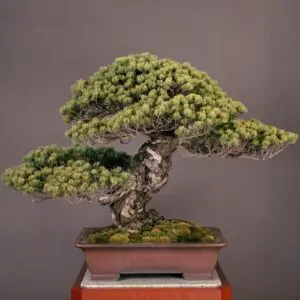
“The Third Shogun”, a 550-year-old Japanese white pine bonsai
I don’t think this particular tree would ever be sold in the market but if it did, you can imagine that the price would be extremely high because of the previous owners of the tree.
Value of the bonsai pot
The value of a bonsai pot can increase the price of a bonsai tree.
A bonsai pot is not only a container for the bonsai tree but also an integral part of the bonsai composition, which complements the bonsai tree aesthetically. The pots serve to represent the landscape where the trees are growing and a well-chosen pot can enhance the overall beauty of the bonsai tree.
This is like a frame to a painting; a perfect frame can increase the price of a painting because it adds value to the painting to draw viewers into it, whose very existence depends on each other.
Also, a bonsai pot itself is a piece of artwork. A good bonsai pot demands the skill of an expert. They are often hand-crafted and one-of-a-kind. And they can be antiques of a few hundred years, all of which is reflected in the final price of the bonsai tree.
Money and time invested
Bonsai cultivation is a long-term investment, both in terms of time and money. Creating a bonsai tree can take many years, and the process is ongoing as the tree must be maintained and cared for throughout its life. This investment in time and money is reflected in the cost of a bonsai tree.
Difficulty of moving trees internationally
As bonsai was perfected as a form of art in Japan, many high-quality bonsai trees are still created there even now. But if you want to purchase these good bonsai trees outside of Japan, you will face two major problems: the difficulty of trees’ acclimation and import/export procedures.
Bonsai trees’ acclimation
As a living plant, a bonsai tree can only live under a certain climate. Moving from one place to another is stressful for a bonsai tree. I may encounter some difficulties adjusting to the new environment and it is possible that the tree may be moved at a very specific time of the year when the weather conditions are most favorable for their transition.
This, of course, adds to the price of the tree.
Import/export procedures
Importing a bonsai tree from Japan to the US is a complex process as it involves meeting the requirements of both countries’ customs and regulations.
In the US, bonsai trees are subject to regulations from the US Department of Agriculture. Usually, importing live plants in soil is prohibited because soil could harbor a number of pests and diseases that could threaten agricultural and natural resources in the US.
In fact, when a lot of world-class bonsai trees were imported into the US from Japan in 2015, people had to go through very complicated processes that involved carefully elaborated planning and execution (reference here).
These difficulties are reflected in the price of a bonsai tree.
The most expensive bonsai tree
It is difficult to determine the most expensive bonsai tree in the world. Bonsai trees have been known to sell for millions of dollars at auction, at Sotherby’s for example, but the prices are usually not publicly disclosed.
However, there are a few famous and expensive bonsai trees for sale in Japan. I cannot tell definitively that these trees are the most expensive bonsai currently sold on the market but they are for sure among the most expensive ones.
Shunkaen Bonsai Museum
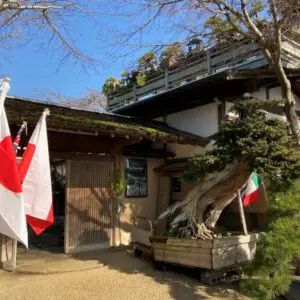
Shunkaen front gate
Both these expensive bonsai trees are sold at Shunkaen Bonsai Museum in Tokyo, Japan. This bonsai museum is established by Kunio Kobayashi, a renowned bonsai grower/artist, in 2002. He has more than 50 years of career as a bonsai grower and has won multiple reputable awards.
The museum is one of the popular tourist destinations as well and many people visit there every year, one of whom is Jeff Bezos (Amazon CEO).
Over 1000 trees are exhibited there and some of them are for sale.
100 million yen Japanese black pine bonsai
This Japanese black pine bonsai is sold at a price of 100 million yen (770K US dollars). It is about 500 years old, very well-shaped, and created and maintained by a famous bonsai artist, Kunio Kobayashi.
The deeply furrowed bark and the interesting curvature of the trunk speak of the strength and the antiquity of Japanese black pine.
100 million yen Japanese juniper bonsai
This Japanese juniper is also sold at a price of 100 million yen (770K US dollars). It is about 1000 years old, very well-shaped, and created and maintained by a famous bonsai artist, Kunio Kobayashi.
The shari, dead white wood, flowing dynamically at the center of the trunk, contrasted with the green of the foliage, is very enticing and captures the eye of the viewers. This is a true piece of art and is one of the finest specimens of Japanese juniper bonsai.


